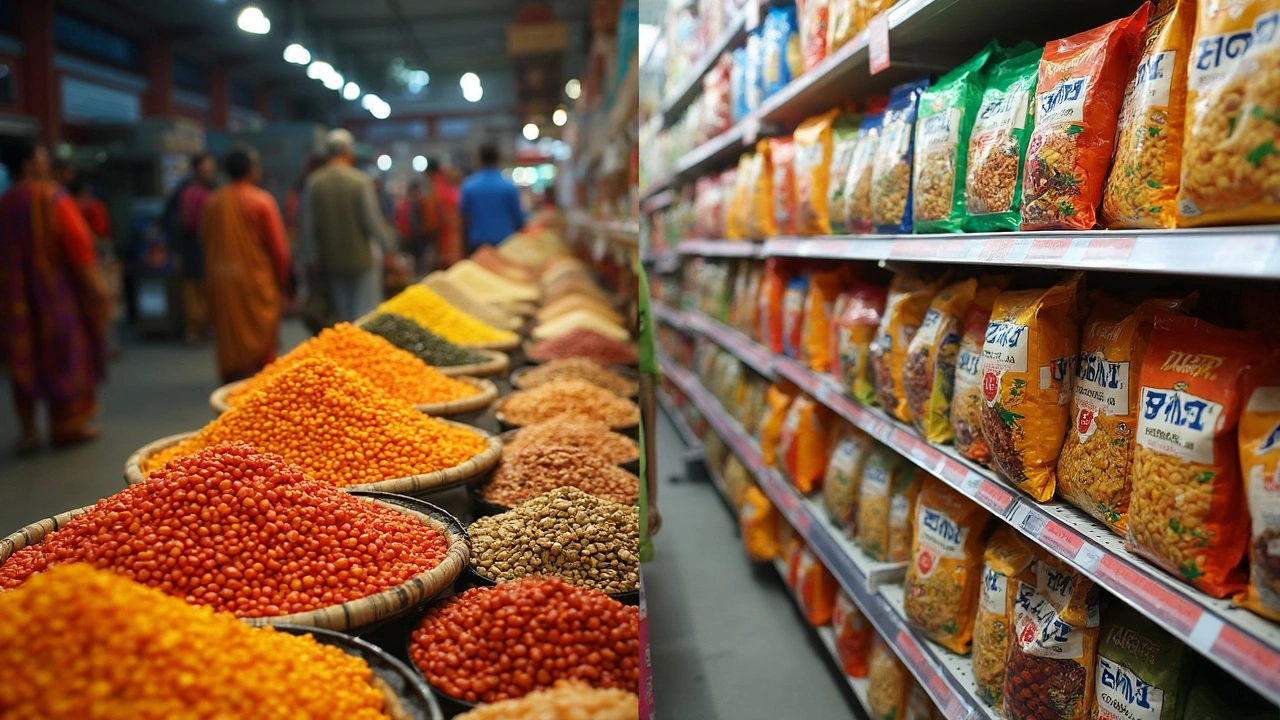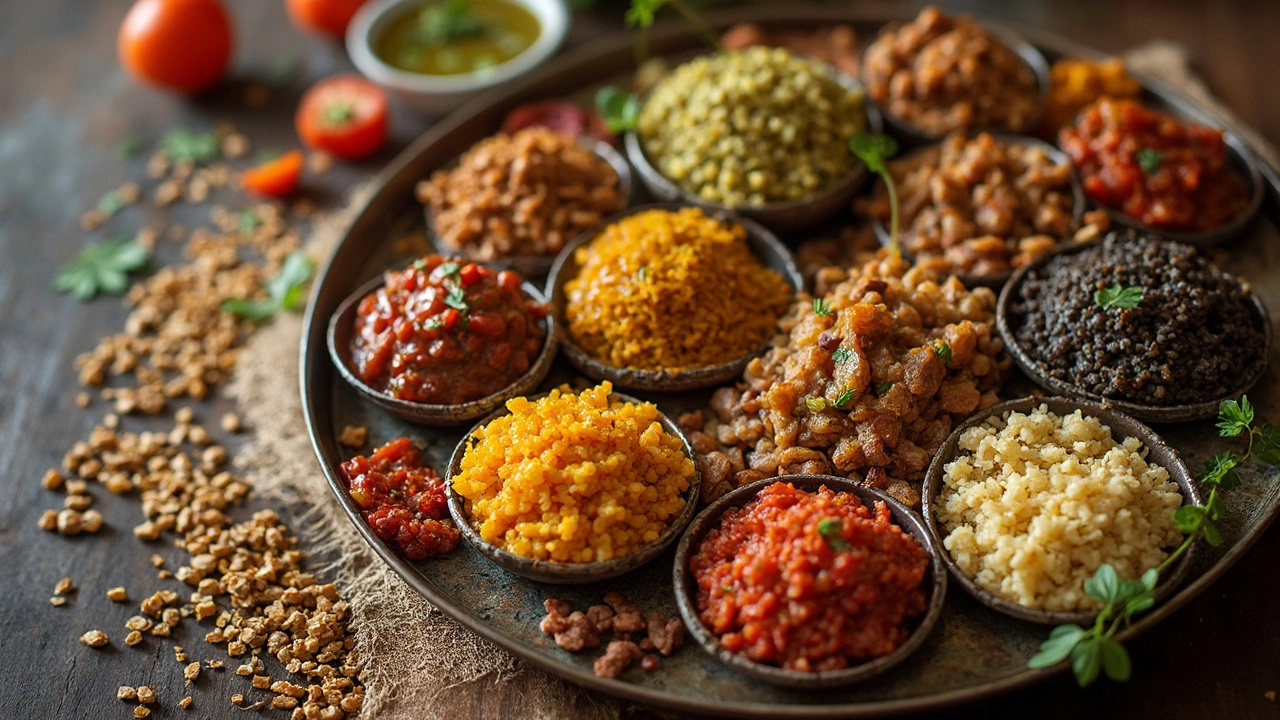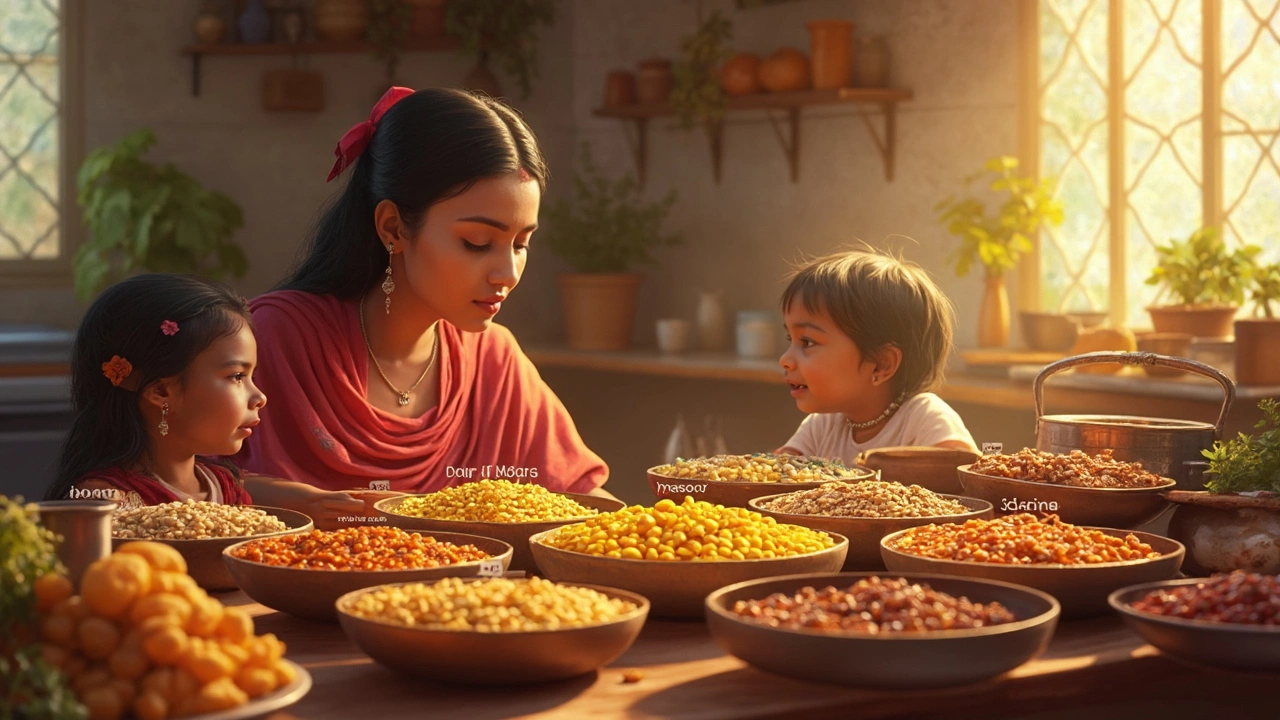27 Apr 2025
- 0 Comments
Walk through any aisle stocked with dry goods and you’ll see bags labeled both “dal” and “lentils.” Easy to assume they’re the same, right? Actually, the difference can mess with your recipes if you’re not careful. Lentils are the round seeds you buy dry, found in colors like brown, green, red, and yellow. They sit right next to chickpeas and beans at the store. But the word "dal" in India means more than just those lentils—it’s got a double meaning that trips people up.
For starters, “dal” is the Hindi word for any split pulse (this can be lentils, but also split peas, mung beans, or even chickpeas). To make things more confusing, dal is also the name for the comforting, stewy dish you get at every Indian kitchen table. So every dal can be made of lentils, but not every lentil is a dal—at least not until it’s split and hulled.
- Understanding Lentils: Not Just One Thing
- What Dal Actually Means (Spoiler: It’s Not Just the Legume)
- Why the Distinction Matters in Home Cooking
- Common Types of Dal and How They’re Used
- Tips for Buying, Cooking, and Storing Dal and Lentils
Understanding Lentils: Not Just One Thing
Think all lentils are basically the same? They're actually super varied. Lentils are small, lens-shaped seeds that belong to the legume family, but they come in a bunch of types. The big families you'll see include brown, green, red, black, and yellow lentils. Each has its own texture, flavor, and best use in the kitchen.
Brown lentils are the ones you spot the most in regular supermarkets, and they hold their shape well during cooking. Green lentils, especially the French "Puy" ones, are great for salads since they stay firm. Red and yellow lentils cook fast and break down into a creamy mush, making them perfect for curries and, you guessed it, dal recipes. Then there’s black lentils, also called "beluga" lentils—they’re tiny, glossy, and don’t fall apart easily, so they’re often tossed in salads or soups.
Lentils aren’t just a single ingredient on your pantry shelf. Different types give you totally different results, so it’s worth paying attention when a recipe calls for a certain kind. Here’s a quick comparison to help clear things up:
| Type | Color | Texture After Cooking | Common Uses |
|---|---|---|---|
| Brown | Light to dark brown | Soft, holds shape | Soups, stews, salads |
| Green | Green, mottled | Firm | Salads, side dishes |
| Red/Yellow | Orange-red, pale yellow | Mushy, creamy | Dal, curries, purees |
| Black (Beluga) | Shiny black | Firm | Salads, pilafs |
Why does this matter? Because if you swap brown lentils for red ones in a dal recipe, you’ll end up with a totally different dish—maybe not the creamy texture you wanted. It pays off to know which lentil you’re picking and why. The next time you spot a bag of lentils, just remember: that color on the label can change the whole meal.
What Dal Actually Means (Spoiler: It’s Not Just the Legume)
Here’s where things get interesting. In Indian cooking, the word dal doesn’t just mean the dried split pulses you see in a bag. It also describes an entire style of dish—the kind that’s cooked until soft, then seasoned and served as that thick, warm stew you scoop up with flatbread or rice.
What counts as dal in the pantry? Most of the time, it’s split and hulled versions of pulses—meaning the outer shells have been removed. For example, red lentils become masoor dal once they’re split and hulled. Chickpeas turn into chana dal when split. Mung beans? Split them and you’ve got moong dal. The big thing is: not all lentils in the West are split and hulled, so if you grab whole ones by accident, your stew might take ages to cook or end up with a totally different texture.
But step into any kitchen from Gujarat to Bengal, and “dal” is also used to talk about the dish itself. Ask someone, “What’s for dinner?” and if the answer is “dal,” they mean the cooked dish, no matter which pulse is inside. The dish is all about transforming these beans into comfort food, spiced up with turmeric, chili, garlic, and more.
So, the double meaning of dal can definitely mess with grocery shopping if you’re not in the know. And it works both ways—a bag labeled dal might only tell you the pulse inside, but it’s also a clue for your next dal recipe simple. Here’s a neat cheat sheet:
- Dal (ingredient): Dried, split, and skinned pulses (like lentils, chickpeas, mung beans).
- Dal (dish): Stewed, spiced thick soup made from one or more kinds of dal.
Just to make it easier, here’s a quick table you can screenshot for your next trip to the Indian grocery:
| Pulse | Indian Dal Name | Common Use |
|---|---|---|
| Split Red Lentil | Masoor Dal | Quick soups, thin dals |
| Split Chickpea | Chana Dal | Hearty stews, curries |
| Split Mung Bean | Moong Dal | Light dals, khichdi |
| Split Pigeon Pea | Toor Dal | Sambar, daily dal |
When you hear dal, always think about context: do you need to grab an ingredient, or is someone inviting you to dinner? Knowing the difference will save you a lot of last-minute kitchen confusion—and guarantee your Indian classics turn out just like you remember.

Why the Distinction Matters in Home Cooking
If you use the wrong type of dal or lentils in a recipe, you might end up with mush or crunch when you wanted the total opposite. For example, split yellow moong dal cooks up super soft and almost creamy, perfect for classic Indian dal soups. Whole brown lentils, though, hold their shape and stay a bit firm, which totally changes the texture and look of your dish. That’s why knowing the difference can save you loads of guesswork—no surprise results.
Most Indian dal recipes call for specific types, like toor dal, masoor dal, or chana dal. Swapping in just any lentil from the store shelf doesn’t always work, because cooking times and flavors vary a lot. Split dals tend to cook faster and break down more. Whole lentils might need an extra half hour on the stove or in the pressure cooker—something you’ll only discover when dinnertime is running late. If you’re following a dal recipe simple and accidentally grab whole green lentils instead of split red, you’ll be stirring much longer than you wanted.
Check out this rough cooking time chart for the most common types:
| Type | Average Cooking Time (Stovetop) |
|---|---|
| Split Yellow Moong Dal | 20-25 minutes |
| Whole Brown Lentils | 30-40 minutes |
| Toor Dal (split pigeon peas) | 25-35 minutes |
| Red Lentils (split masoor) | 15-20 minutes |
Flavor is another thing. Dals like chana dal have a nutty flavor and thick texture, making them great for hearty, filling dishes. Red lentils turn silky and mild, so they work well in lighter soups. If you’re looking to copy a restaurant dal at home, matching the right lentil or dal is half the trick.
Here’s a quick tip: When you see “dal” in a recipe, don’t just buy any package labeled lentils. Look for the specific name: toor, masoor, moong, or chana. Learning the types makes shopping simpler, and your dal recipe simple will actually turn out the way you expected.
Common Types of Dal and How They’re Used
If you start digging into the world of dal, you’ll see there’s more than just one type. What you grab depends on the dish you want, since each has its own texture, taste, and even cook time. Let’s look at the ones you’ll spot the most in a typical Indian kitchen or that “dal recipe simple” you found online.
- Toor Dal (Split Pigeon Peas): This one’s the backbone of classics like sambar and Gujarati dal. It’s creamy when cooked, soaks up spices, and needs a bit longer to cook compared to others if you’re not using a pressure cooker.
- Moong Dal (Split Mung Beans): Comes split with or without skins. The yellow, skinless version cooks super fast, is easy on the stomach, and has a mild flavor—perfect for everyday “comfort food” type dal.
- Chana Dal (Split Black Chickpeas): Looks chunky and bright yellow. Adds a little bite and nutty taste to stews, so it holds up well in dishes with a lot of veggies or coconut. It needs soaking or it’ll take forever to soften.
- Masoor Dal (Red Lentils): Reddish-orange but turns a golden yellow once cooked. It gets mushy super quick, which is why it’s great for thick, hearty recipes or when you’re short on time.
- Urad Dal (Split Black Gram): The star of dal makhani and also used for dosas and idlis (in the fermented batter form). It has a strong flavor and is stickier than other dals when cooked slow.
Most folks in India use a pressure cooker for these, but they all work in a regular pot—just expect the time to double. And here’s a quick cheat sheet:
| Type of Dal | Usual Cook Time (stovetop) | Common Use |
|---|---|---|
| Toor Dal | 30-40 min | Sambar, Gujarati dal |
| Moong Dal | 20-25 min | Simple dals, khichdi |
| Chana Dal | 40-50 min | Chana dal fry, stews |
| Masoor Dal | 15-20 min | Quick dals, soups |
| Urad Dal | 35-45 min | Dal makhani, idli batter |
You can mix different dals in one dish for more protein or just to switch up textures. And if a recipe says “dal” with no other clue, try starting with toor or moong—they’re always a safe bet.

Tips for Buying, Cooking, and Storing Dal and Lentils
Buying dal and lentils doesn’t have to be stressful. Go for clear, unbroken grains, and steer clear of packages that look dusty or faded. Split dals like moong or masoor usually cook faster than whole lentils, so check your recipe before you buy. If you’re after authenticity in Indian dishes, pick up split dals over regular lentils—they’re what most dal recipes use.
Ever stood in the aisle stuck between red, brown, and yellow lentils? Here’s a cheat sheet:
- Red/orange lentils (masoor dal): Turn mushy and creamy, perfect for simple dal or soups.
- Yellow or moong dal: Mild and fast-cooking, great for easy dal recipes and kids’ meals.
- Brown/green lentils: Hold shape, not traditional in dal but work well in salads or hearty Western dishes.
Before cooking, rinse your dal or lentils in plenty of water. This gets rid of extra starch and any dust. Some folks like to soak dals for 20-30 minutes—helps them cook softer and faster, especially if they’re old stock.
A quick look at cook times and water ratios can save you from a mushy or crunchy disaster. Here’s a basic table for stovetop cooking:
| Type | Water Ratio | Cook Time |
|---|---|---|
| Red Lentils (Masoor) | 1:2.5 | 12-15 min |
| Yellow Moong Dal | 1:3 | 20 min |
| Whole Brown Lentils | 1:3 | 30-35 min |
Add salt after the dal is soft; adding it at the start can toughen the skins. Spices like turmeric, cumin, and asafoetida give classic flavor—drop those in with your water for more depth.
Storing is easy: keep lentils and dal in airtight jars, away from sunlight. Old lentils take forever to cook, so buy in small batches if you can. Be sure to use dal within a year—fresh means softer and tastier.
Last thing: don’t mix up your dals after you open them. Label jars (masking tape works fine) so your chana dal doesn’t end up where your masoor belongs. Simple step, big time saver when you’re in a hurry to make your next dal recipe simple.
